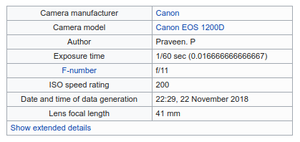Exif
Metadata standard in digital images / From Wikipedia, the free encyclopedia
Dear Wikiwand AI, let's keep it short by simply answering these key questions:
Can you list the top facts and stats about Exchangeable image file format?
Summarize this article for a 10 years old
Exchangeable image file format (officially Exif, according to JEIDA/JEITA/CIPA specifications)[5] is a standard that specifies formats for images, sound, and ancillary tags used by digital cameras (including smartphones), scanners and other systems handling image and sound files recorded by digital cameras. The specification uses the following existing encoding formats with the addition of specific metadata tags: JPEG lossy coding for compressed image files, TIFF Rev. 6.0 (RGB or YCbCr) for uncompressed image files, and RIFF WAV for audio files (linear PCM or ITU-T G.711 μ-law PCM for uncompressed audio data, and IMA-ADPCM for compressed audio data).[6] It does not support JPEG 2000 or GIF encoded images.
 Exif of a file in Wikimedia Commons (compact form) | |
| Filename extension | |
|---|---|
| Developed by | JEIDA, now JEITA, CIPA |
| Initial release | 1995; 28 years ago (1995)[3] |
| Latest release | |
| Extended from | TIFF, JPEG, WAV |
| Extended to | DCF |
This standard consists of the Exif image file specification and the Exif audio file specification.